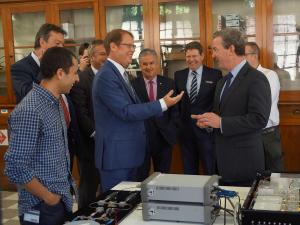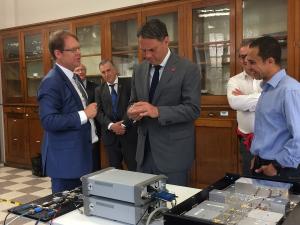Cryogenic Sapphire Oscillator - 'The Sapphire Clock'
Timing precision is critical in many sensing, communication and computational tasks. The call for very high timing precision reaches its pinnacle in radar technology, very long baseline (VLBI) radio astronomy and quantum computing to choose three examples.
IPAS researchers have developed a Cryogenic Sapphire Oscillator, or Sapphire Clock, that produces an extremely pure signal at a microwave frequency of about 10 GHz and allows time measurements with accuracy on the femtosecond scale; performing 10 to 1000 times better than any competing technology.
Such a performance gain allows users to take ultra-high precision measurements to improve the performance of electronic systems.
-
The technology
The Cryogenic Sapphire Oscillator has a 5 cm cylinder-shaped sapphire crystal that is cooled to about -267 °C, or about 5 or 6 degrees above absolute zero. At this temperature, the microwave energy lost in the sapphire crystal is the lowest of any substance on Earth. Microwave radiation is injected into the sapphire crystal and propagates around the circumference of the crystal (just inside the surface). The way the microwave radiation moves around the crystal is called a “Whispering Gallery”. Lord Rayleigh first discovered this concept in 1878 when he could hear someone whispering far away on the other side of the church dome at St Paul’s Cathedral.
There is one particular frequency that will excite the natural resonance of the sapphire crystal – this corresponds to the signal that reinforces itself after one round trip around the crystal surface. A good analogy might be to imagine hitting a bell and using its regular oscillations to count time. The losses in sapphire are so low that if it were a conventional bell then it would keep ringing for millions of years. However, in the sapphire crystal the resonant frequency is so high—10 billion cycles per second—that the electromagnetic signal rings only for a hundred milliseconds.
The Sapphire Clock has a short-term fractional frequency stability of around 1x10-15, which is equivalent to only losing or gaining one second every 40 million years. Its long-term frequency performance is also exceptional (about 10-15 after one day of averaging). We also see some exponentially decreasing aging of the output frequency due to mechanical relaxation of the sapphire crystal after 1 month of operation its fractional frequency drift becomes less than 1x10-14/day.
-
Defence applications
The culmination of 20 years of leading-edge fundamental research, combined with cutting-edge engineering, has led to a disruptive technology that is now revolutionizing a vital Australian defence asset. The Sapphire Clock offers a 1000-fold improvement in timing precision, which delivers an improved capability for Australian Defence to identify threats to Australia using the Jindalee Over-The-Horizon Radar Network.
Radar works by broadcasting highly complex radio or microwave signals from a transmitter. If these emitted signals intercept an object then part of the signal may be reflected back to a receiver antenna. These reflected signals contain information on the location, speed and size of the object. However, the performance of the radar is critically dependent on the purity and quality of the signals that are broadcast: if one can broadcast noiseless signals then will be possible to detect smaller objects that are further away and which are moving slower. This additional surveillance power is critically important in a defence context by providing additional insight.
To answer this call for better radar signals the Sapphire Clock team commenced working closely with the High-frequency Radar team at DST Group who are responsible for the research behind the JORN project. The Sapphire Clock is the culmination of 20 years of leading-edge fundamental research which has shown world-beating performance in the lab. The clock is so good its performance is the equivalent of only losing or gaining one second every 40 million years. When applied to the JORN radar application it delivers a signal that is more than 1000 times purer than its existing approach. It is important to note that this improvement can still be delivered despite the existing JORN solution making use of the best commercial devices that money can buy.
Frequency synthesis and dissemination over optical fibre
In addition to the remarkable Sapphire Clock, the team has developed two additional technologies that directly result in purer signals for JORN, and which thus assist Australian defence to be better able to observe threats to Australia. Firstly, the team has developed ultra-low noise synthesis technology that can take the clock signals and generate the frequencies that are needed by the radar: it can do this while preserving the signal purity of the clock. Secondly, the team has developed signal dissemination technology, which enables them to deliver the pure signals through optical fibre to the numerous locations necessary to broadcast the JORN signals effectively. The range of technologies developed by the team provides the revolutionary leap in the performance in this outstanding Australian invention.
-
Publications
- W. A. Al-Ashwal, A. Hilton, A. N. Luiten, J. G. Hartnett, Low Phase Noise Frequency Synthesis for Ultra-Stable X-Band Oscillators, IEEE Microwave and Wireless Components Letters 27, 392-394 (2017).
- M. S. Heo, S. E. Park, W. K. Lee, S. B. Lee, H. G. Hong, T. Y. Kwon, C. Y. Park, D. H. Yu, G. Santarelli, A. P. Hilton, A. N. Luiten, J. G. Hartnett, Drift-Compensated Low-Noise Frequency Synthesis Based on a cryoCSO for the KRISS-F1, IEEE Transactions on Instrumentation and Measurement, 99, 1-6 (2016).
- J. G. Hartnett, M. E. Tobar, E. N. Ivanov, A. N. Luiten, Optimum design of a high-Q roomtemperature whispering-gallery-mode X-band sapphire resonator. IEEE Transactions on Ultrasonics, Ferroelectrics, and Frequency Control 60, 1041-1047 (2013).
- J.G. Hartnett, N.R. Nand and C. Lu, Ultra-low-phase-noise cryocooled microwave dielectricsapphire-resonator oscillators, Appl. Phys. Lett., 100, 183501, (2012).
- J.G. Hartnett and A.N. Luiten, Colloquium: Comparison of astrophysical and terrestrial frequency standards, Rev. Mod. Phys. 83, 1-9 (2011).
- M. E. Tobar, E. N. Ivanov, C. R. Locke, P. L. Stanwix, J. G. Hartnett, A. N. Luiten, R. B. Warrington, P. T. H. Fisk, M. A. Lawn, M. J. Wouters, S. Bize, G. Santarelli, P. Wolf, A. Clairon, P. Guillemot, Long-term operation and performance of cryogenic sapphire oscillators. IEEE Transactions on Ultrasonics, Ferroelectrics, and Frequency Control 53, 2386-2391 (2006).
- S. Bize, P. Laurent, M. Abgrall, H. Marion, I. Maksimovic, L. Cacciapuoti, J. Grünert, C. Vian, F. Pereira dos Santos, P. Rosenbusch, P. Lemonde, G. Santarelli, P. Wolf, A. Clairon, A. Luiten, M. Tobar, C. Salomon, Advances in atomic fountains. Comptes Rendus Physique 5, 829-846 (2004).
- P. Wolf, S. Bize, A. Clairon, A. N. Luiten, G. Santarelli, M. E. Tobar, Tests of Lorentz invariance using a microwave resonator. Physical Review Letters 90, 060402/060401-060402/060404 (2003).
- J. G. Hartnett, A. N. Luiten, J. Krupka, M. E. Tobar, P. Bilski, Influence of paramagnetic chromium ions in crystalline YAG at microwave frequencies. Journal of Physics D: Applied Physics 35, 1459-1466 (2002).
- A. G. Mann, C. Sheng, A. N. Luiten, Cryogenic sapphire oscillator with exceptionally high frequency stability. IEEE Transactions on Instrumentation and Measurement 50, 519-521 (2001).
- Y. Sortais, S. Bize, M. Abgrall, S. Zhang, C. Nicolas, C. Mandache, P. Lemonde, P. Laurent, G. Santarelli, N. Dimarcq, P. Petit, A. Clairon, A. Mann, A. Luiten, S. Chang, and C. Salomon, Cold atom clocks. Physica-Scripta T95, 50-57 (2001).
- S. Chang, A. G. Mann, A. N. Luiten, Improved cryogenic sapphire oscillator with exceptionally high frequency stability. Electronics Letters 36, 480-481 (2000).
- G. Santarelli, P. Laurent, P. Lemonde, A. Clairon, A. G. Mann, S. Chang, A. N. Luiten, C. Salomon, Quantum projection noise in an atomic fountain: A high stability cesium frequency standard. Physical Review Letters 82, 4619-4622 (1999).
- A. N. Luiten, M. E. Tobar, J. Krupka, R. Woode, E. N. Ivanov, A. G. Mann, Microwave properties of a rutile resonator between 2 and 10 K. Journal of Physics D: Applied Physics 31, 1383-1391 (1998).
- S. Chang, A. G. Mann, A. N. Luiten, D. G. Blair, Measurements of radiation pressure effect in cryogenic sapphire dielectric resonators. Physical Review Letters 79, 2141-2144 (1997).
- A. N. Luiten, A. G. Mann, D. G. Blair, High-resolution measurement of the temperature-dependence of the Q, coupling and resonant frequency of a microwave resonator. Measurement Science and Technology 7, 949-953 (1996).
- A. N. Luiten, A. G. Mann, D. G. Blair, Paramagnetic susceptibility and permittivity measurements at microwave frequencies in cryogenic sapphire resonators.Journal of Physics D: Applied Physics 29, 2082-2090 (1996).
- J. Krupka, D. Cros, A. Luiten, M. Tobar, Design of very high Q sapphire resonators. Electronics Letters 32, 670-671 (1996).
- A. N. Luiten, A. G. Mann, M. E. Costa, D. G. Blair, Power stabilized cryogenic sapphire oscillator. IEEE Transactions on Instrumentation and Measurement, 44 (2), 132-135 (1995).
- A. N. Luiten, A. G. Mann, D. G. Blair, Cryogenic sapphire microwave resonator-oscillator with exceptional stability. Electronics Letters 30, 417-419 (1994).
- M. E. Costa, A. N. Luiten, M. E. Tobar, D. G. Blair, Oscillator performance from the time evolution of relative phase. Electronics Letters 30, 149-151 (1994).
- M. E. Costa, J. W. He, A. S. Mann, A. N. Luiten, D. G. Blair, Combined sapphire oscillator-hydrogen maser frequency standard. Electronics Letters 30, 2119-2120 (1994).
- A. N. Luiten, A. G. Mann, A. J. Giles, D. G. Blair, Ultra-stable sapphire resonator-oscillator. IEEE Transactions on Instrumentation and Measurement 42, 439-443 (1993).
- A. N. Luiten, A. G. Mann, D. G. Blair, Ultrahigh Q-factor cryogenic sapphire resonator. Electronics Letters 29, 879-881 (1993).
- M. E. Costa, D. G. Blair, M. J. Buckingham, A. J. Giles, S. K. Jones, A. N. Luiten, P. J. Turner, A. C. Young, P. Hong, A. G. Mann, Sapphire oscillator for VLBI radio astronomy. Measurement Science and Technology 3, 718-722 (1992).
- D. L. Jauncey, J. E. Reynolds, A. K. Tzioumis, T. W. B. Muxlow, R. A. Perley, D. W. Murphy, R. A. Preston, E. A. King, A. R. Patnaik, D. L. Jones, D. L. Meier, D. J. Bird, D. G. Blair, J. D. Bunton, R. W. Clay, M. E. Costa, R. A. Duncan, R. H. Ferris, R. G. Gough, P. A. Hamilton, D. W. Hoard, A. Kemball, M. J. Kesteven, E. T. Lobdell, A. N. Luiten, P. M. McCulloch, J. D. Murray, G. D. Nicolson, A. P. Rao, A. Savage, M. W. Sinclair, L. Skjerve, L. Taaffe, R. M. Wark, G. L. White, An unusually strong Einstein ring in the radio source PKS1830-211. Nature 352, 132-134 (1991).
Videos
Defence applications
Interview with ABCNEWS
ABC News - Light Years Ahead
2018 Eureka Prize


